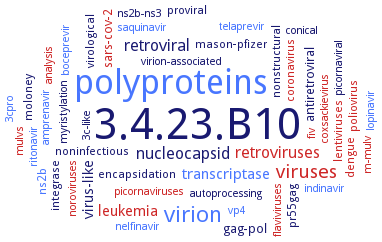3.4.23.B10: Rous sarcoma virus retropepsin
This is an abbreviated version!
For detailed information about Rous sarcoma virus retropepsin, go to the full flat file.

Word Map on EC 3.4.23.B10 
-
3.4.23.B10
-
polyproteins
-
virion
-
viruses
-
retroviruses
-
retroviral
-
nucleocapsid
-
transcriptase
-
leukemia
-
virus-like
-
antiretroviral
-
gag-pol
-
sars-cov-2
-
noninfectious
-
moloney
-
proviral
-
mason-pfizer
-
poliovirus
-
pr55gag
-
integrase
-
nonstructural
-
lentiviruses
-
dengue
-
encapsidation
-
coronavirus
-
virological
-
ns2b
-
ns2b-ns3
-
nelfinavir
-
lopinavir
-
fiv
-
coxsackievirus
-
picornaviruses
-
m-mulv
-
virion-associated
-
flaviviruses
-
autoprocessing
-
boceprevir
-
noroviruses
-
3cpro
-
vp4
-
saquinavir
-
picornaviral
-
indinavir
-
myristylation
-
3c-like
-
mulvs
-
conical
-
amprenavir
-
analysis
-
ritonavir
-
telaprevir
- 3.4.23.B10
- polyproteins
- virion
- viruses
- retroviruses
-
retroviral
-
nucleocapsid
- transcriptase
- leukemia
-
virus-like
-
antiretroviral
- gag-pol
- sars-cov-2
-
noninfectious
-
moloney
-
proviral
-
mason-pfizer
- poliovirus
-
pr55gag
-
integrase
-
nonstructural
- lentiviruses
- dengue
-
encapsidation
- coronavirus
-
virological
- ns2b
-
ns2b-ns3
- nelfinavir
- lopinavir
- fiv
- coxsackievirus
- picornaviruses
- m-mulv
-
virion-associated
- flaviviruses
-
autoprocessing
- boceprevir
- noroviruses
- 3cpro
- vp4
- saquinavir
-
picornaviral
- indinavir
-
myristylation
-
3c-like
- mulvs
-
conical
- amprenavir
- analysis
- ritonavir
- telaprevir
Reaction
The cleavage sequence in the natural substrate NC-PR is PPAVS-/-LAMTMRR. The activity can be improved by substitution by Trp, Tyr, Phe, Leu, Arg, Glu, His or Ala in P1, Tyr in P3', and Arg, Phe, Asn or His in P3 =
Synonyms
AMV PR, AMV/RSV PR, avian myeloblastosis virus protease, avian myeloblastosis virus retropepsin, capsid protein P27, core protein P10, core protein P19, core protein P2A, core protein P2B, Gag polyprotein, Gag polyprotein p10 sequence, inner coat protein P12, More, p10-CA protease, p10-capsid protease, p15 protein, protease P15, Rous sarcoma virus protease, Rous sarcoma virus retropepsin, RSV PR, RSV protease, RSV/AMV retropepsin, viral protease


 results (
results ( results (
results ( top
top






